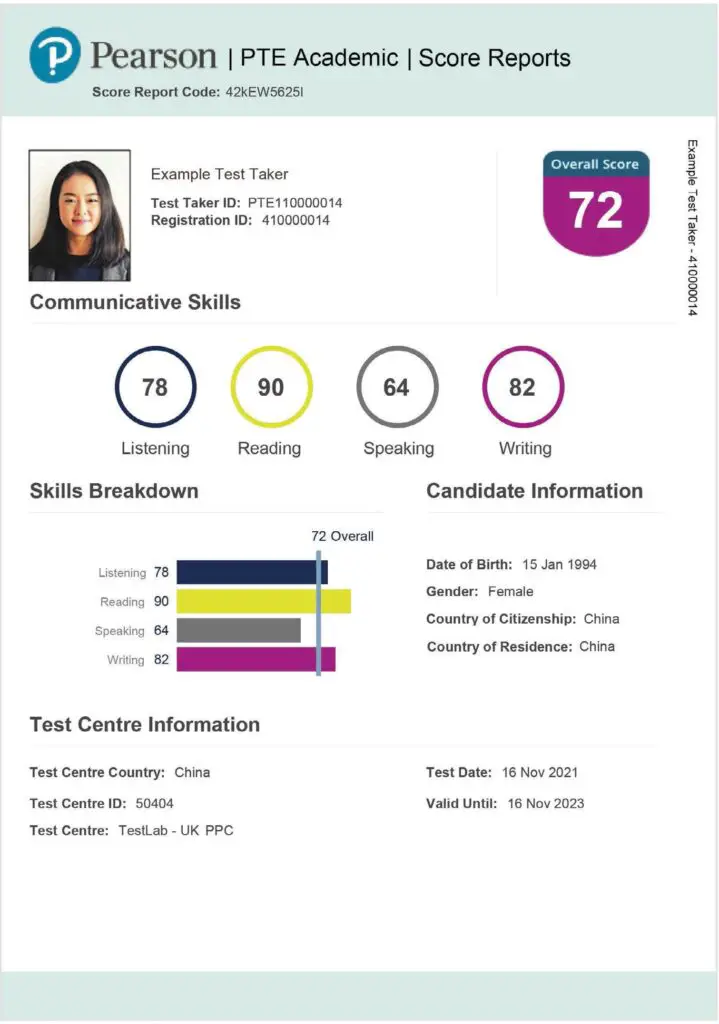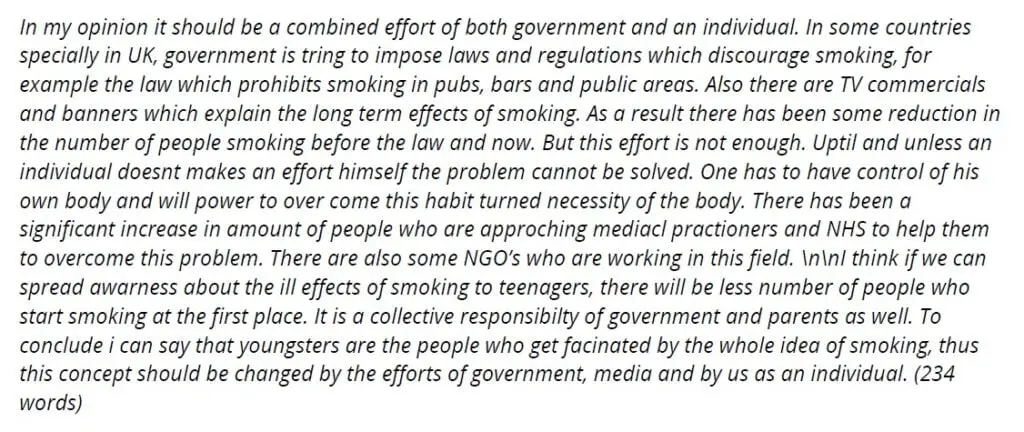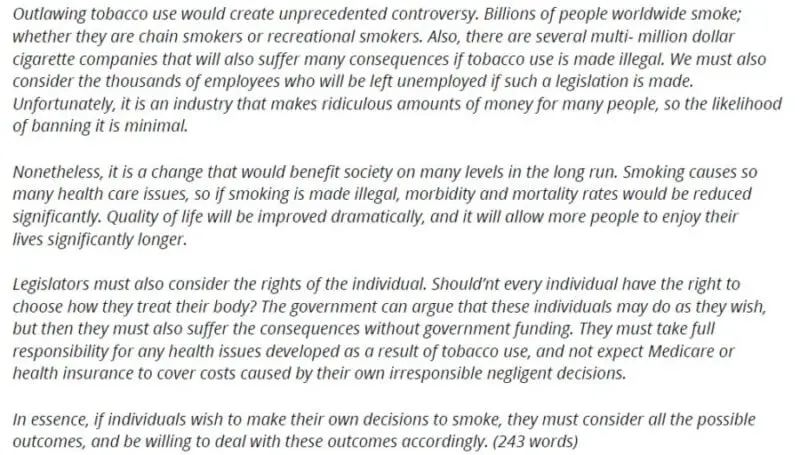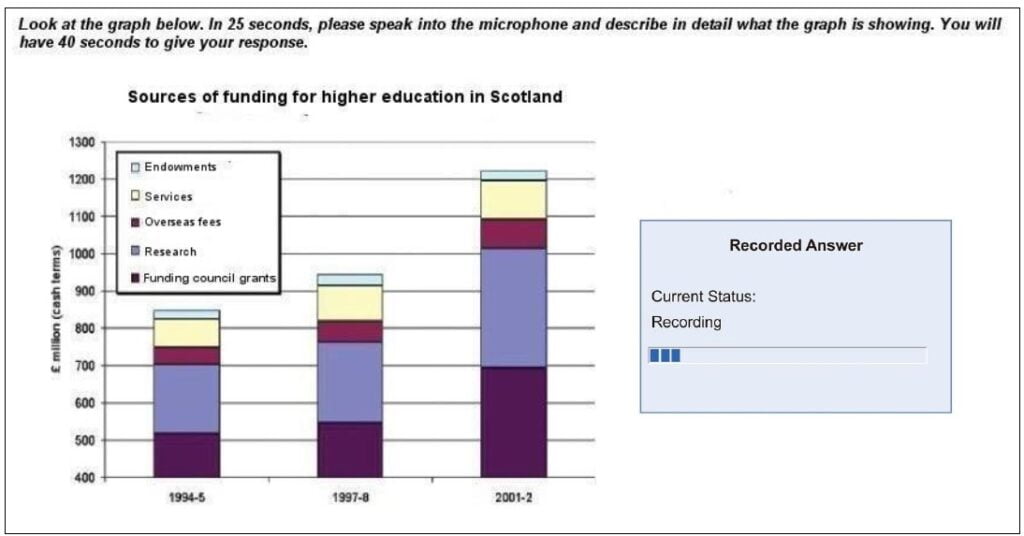The Pearson PTE test is conducted, evaluated, and marked by a computer-automated scoring system. Essentially, there is no involvement of a human in the marking process of the PTE Academic exam.
This may sound incredible, but PTE Academic has successfully been using software technology to judge test takers’ answers and automatically compute an English language proficiency score since 2009.
Let us understand in depth about PTE marking system and what the PTE score format is in order to better prepare for the PTE Academic test.
PTE Academic Score Report

You can see the overall score of 72 in the top right corner and the score for the four sections just below it: 78 in Listening, 90 in Reading, 64 in Speaking, and 82 in Writing.
The overall score is not simply an average of the four Communicative Skills: Listening, Reading, Speaking, and Writing.
Instead, the overall score is calculated by factoring in different language skills, including grammar, oral fluency, pronunciation, spelling, vocabulary, and written discourse.
For any purpose – university admission or visa – the overall score and the four Communicative Skills scores matter. Institutions and immigration departments set a minimum score criteria for overall as well as the four bands.
For example, to get enrolled in the MBA course of University of Sydney, you need to score a minimum of 68 overall and at least 54 in each band.
The range for each of these scores is 10 to 90, based on the Global Scale of English, which is different from the 9-band scoring system of IELTS.
If you are looking for a breakdown of the PTE exam format, click here »
PTE marking system in short
- Some questions have a single short correct answer. A correct answer gets 1 point, while an incorrect answer gets no point. This applies to questions like Answer Short Question and Fill in the Blanks.
- Some questions require a specific form of answer. For example, the Write Essay question in the Writing Section mandates that answers be within the word limit of 200 to 300 words. Partial score is given if the answer is over or under the requirement.
- Quality of response is the third factor used to score Speaking and Writing answers. The score is based on English language skills such as grammar, oral fluency, pronunciation, spelling, vocabulary, and written discourse.
Remember that the score you get in the test is not marks but a scale. Unlike traditional exams, you are not asked several questions worth 90 marks. The total number of marks for all the questions is not fixed, as the number of questions that each test taker gets is different. Your raw scores are converted into a scale of 10 to 90 by computer algorithm.
For example, if you get two Summarize written text questions and one Write essay question in the exam, the total raw score available for the Writing section will be 29. If your raw score is 20 out of available 29, it is converted into a scale of 90. To get a rough estimate, you could divide 20 by 29 and multiply by 90. In our example, the figure comes at 62 out of 90. Although actual calculation of scores is more complicated (and Pearson doesn’t share all the details), you can assume that the number is the actual score for practice purposes.
For more details about raw score calculation, see below.
PTE Score Format: Understanding Enabling Skills scores
Enabling Skills highlight the ability of individuals to communicate in spoken or written English.
Grammar means your competence to apply correct language in the sentences you use in your answers. It checks grammatical structures, in relation to things like subject-verb agreement and word order, as well as the ability to use complex language.
Oral Fluency checks your delivery of speech in the Speaking section and whether it is smooth and naturally-paced.
Pronunciation is the skill to be understood while producing speech sounds. A regular user of the English language should easily understand your words. Variations in pronunciations and accents depending on location are acceptable as long as they are correctly understood.
Spelling is straightforward. Words should be written (typed, to be more exact) based on the dictionary version of either American or British English.
Vocabulary means making an appropriate choice of words and showing a range of your lexical resource. For example, the sentence “He was watching television” is more appropriate than “He was looking television.” Similarly, to show range, instead of repeating the same word over and over again in your answers, it is better to use synonyms.
Written Discourse judges your structure of answers in terms of logical development and meaning of your points or arguments.
But how does a computer give score? This is how PTE score is calculated

Pearson, the organization which created PTE Academic, has developed advanced technologies called the automated scoring engines. For PTE tests, the engines have been fed millions of sample answers from thousands of individuals from all over the world. These individuals, who participated in the research, were people from diverse backgrounds and not just native English speakers.
Therefore, the automated scoring engines of PTE are equipped with vast amounts of data to learn the pattern of human writing and speech, particularly in response to the types of questions asked in the exam.
Additionally, the automated scoring engines have been trained to evaluate the answers and assign a score based on methods used by actual human examiners. Scores given to test takers by human raters in the research are used by the software as the basis.
Think of how your phone autocorrects your messages as you type, or how Google Search completes your question before you finish, or how grammatically faulty sentences are highlighted by Microsoft Word. A similar technology is at work here.
PTE Scoring of written answers
PTE Academic uses an automated scoring engine called the Knowledge Analysis Technology (KAT) to understand the meaning of written answers. A mathematical technique called Latent Semantic Analysis, whereby a huge number of texts are analyzed, is employed by KAT to assess test takers’ answers.
The marking is done by a program known as the Intelligent Essay Assessor. This tool is capable of comprehending written discourse and finding out if the answers are going off-topic.
Sample of writing score given by PTE software
Question

Answer 1

Machine score: 8.18 out of 14.
In PTE terms, this would be around 53 out of 90, which is the average level of academic English.
Answer 2

Machine score: 9.84 out of 14.
In PTE terms, this would be around 64 out of 90, which is the level of an independent and confident user of English.
Answer 3

Machine score: 13.23 out of 14.
In PTE terms, this would be around 85 out of 90, which is the level of an advanced and expert user of English.
PTE Marking System: Evaluation of speaking
Pearson’s Ordinate technology is at play in scoring the speaking portion of the PTE test. Factors such as speed and rhythm of speech, alongside voice quality, intonation, word choice, and pronunciation are taken into account by the computer.
Sample of speaking score given by PTE software
Question

Answer 1
https://youtu.be/xt9jZWnOqHo (Playback on other websites has been disabled by the video owner, so you have to open this link manually.)
Machine score: 4.72 out of 15.
In PTE terms, this would be around 28 out of 90, which is a very basic level of academic English.
Answer 2
https://youtu.be/xSypJ-nVl-Y (Playback on other websites has been disabled by the video owner, so you have to open this link manually.)
Machine score: 9.49 out of 15.
In PTE terms, this would be around 57 out of 90, which is the level of an independent user of English.
Answer 3
https://youtu.be/XQs84fFhVYI (Playback on other websites has been disabled by the video owner, so you have to open this link manually.)
Machine score: 10.75 out of 15.
In PTE terms, this would be around 65 out of 90, which is the level of an independent and confident user of English.
The complete PTE Score Guide 2023 for all 20 question types in PTE
Speaking
| Question type | PTE Marking system |
| Read aloud | Each word from the question is one mark for Content. Inserting, omitting, or replacing the words is an error. Pronunciation and Oral Fluency each are assigned a score from 0 to 5, with 5 being native-like use of the language and 0 being unrecognizable or inarticulate English. |
| Repeat sentence | You get 3 out of 3 in Content, if you repeat all the words from the question. 2 out of 3 is for 50 percent correct, while 1 out of 3 is for 25 percent correct. Less than that is 0. Pronunciation and Oral Fluency each are assigned a score from 0 to 5, with 5 being native-like use of the language and 0 being unrecognizable or inarticulate English. |
| Describe image | Content is scored on a scale of 0 to 5. An answer which covers all the relevant parts of the image and their relationships and implications gets 5. The more elements from the image you fail to describe, the lower your score will be. Pronunciation and Oral Fluency each are assigned a score from 0 to 5, with 5 being native-like use of the language and 0 being unrecognizable or inarticulate English. |
| Re-tell lecture | Content is scored on a scale of 0 to 5. An answer which covers all the relevant aspects of the lecture and their relationships and conclusions gets 5. The more points from the lecture you fail to describe, the lower your score will be. Pronunciation and Oral Fluency each are assigned a score from 0 to 5, with 5 being native-like use of the language and 0 being unrecognizable or inarticulate English. |
| Answer short question | 1 for a correct answer. 0 for a wrong answer. |
The criteria for Pronunciation and Oral Fluency in detail
Pronunciation
| 5 | Native-like | The speech sounds should be easily comprehensible to common users of the English language, with appropriate stress placed within words as well as at the sentence level. |
| 4 | Advanced | The pronunciation is understandable but there are minor errors in vowel sounds, consonant sounds, and stress. |
| 3 | Good | Mostly correct pronunciation, but errors in consonant sounds and stress may make some words difficult to understand. |
| 2 | Intermediate | Consistent mispronunciation of words with about a third of the answer being unintelligible. |
| 1 | Intrusive | Listeners find it difficult to understand two thirds of the speech. |
| 0 | Non-English | More than half of the response cannot be understood at all. Pronunciation and stress are used in a non-English manner. |
Oral Fluency
| 5 | Native-like | A smooth rhythm of speech with appropriate phrasing, and enunciation like a native speaker of English. No repetitions, no hesitations, and no false starts. |
| 4 | Advanced | An acceptable rhythm of speech with appropriate phrasing, and very minor enunciation variation from a native speaker. There should not be more than one hesitation and one repetition. |
| 3 | Good | Uneven speech but continuous without long pauses. More than one hesitation and a few repetitions. |
| 2 | Intermediate | Uneven speech with only one long pause. No more than three hesitations and repetitions. |
| 1 | Limited | Unnatural phrasing of words. Multiple long pauses, along with multiple hesitations and repetitions. |
| 0 | Non-user | Gaps between words or incorrect word emphasis make meaning difficult to understand. A lot of pauses, hesitations, repetitions, and false starts. |
Writing
| Question type | PTE Marking system |
| Summarize written text | Content score goes from 0 to 2, depending on whether the relevant aspects of the question are covered or missed. Form: you get 1 mark for writing a single sentence between 5 and 75 words; 0 for an incomplete sentence, or more than one sentence, or writing under or beyond the word limit. Grammar: 2 for no grammatical errors; 1 for some grammatical errors but without failure to communicate message; 0 for multiple faulty sentence structures. Vocabulary: 2 for appropriate word choices; 1 for few errors; 0 for multiple errors. |
| Write essay | Content has a maximum score of 3 depending on the relevance of the response to the question. Form: an essay between 200 and 300 words gets 2 out of 2 marks. If the essay is between 120 and 199 words or between 301 and 380 words, you get 1 mark. An essay shorter than 120 words or longer than 380 words gets no score in this criterion. Development, structure, and coherence: there is a maximum score of 2 based on the overall format of the essay and the link between paragraphs. Grammar: 2 for consistently correct grammatically complex sentences; 1 for some grammatical error but without failure to communicate message; 0 for multiple faulty sentence structures. General linguistic range: a maximum of 2 marks based on the ability to express ideas with clarity and precision. Vocabulary range has 2 marks reserved for answers with a wide variety of words, phrases, and idioms. Spelling: 2 out 2 if there is no spelling error. 1 out of 2 for one spelling error, while 0 out of 2 for more than one spelling errors. |
Reading
| Question type | PTE Marking system |
| Reading and writing: Fill in the blanks | 1 mark for each correct answer in the blank. |
| Multiple-choice, choose multiple answers | 1 mark for each correct choice. 1 mark is deducted for making an incorrect choice. For an instance, if the correct answers are options ‘A’ and ‘B’ but you selected ‘A’ and ‘C’, then you get +1 for A and -1 for C, which means you get 0 overall. Making multiple errors will not reduce your score below 0. |
| Re-order paragraphs | 1 mark for each set of two correct answers. For example, if the correct sequence is A-B-C-D-E and your answer is A-C-B-D-E, there is only set of two correct answers: D and E. So, you get 1 mark. Although A is correct, it does not get any score because it is not part of a correct pair. |
| Reading: Fill in the blanks | 1 mark for each correct word in the blank. |
| Multiple choice: choose single answer | 1 mark for each correct choice |
Listening
| Question type | PTE Marking system |
| Summarize spoken text | Content score goes from 0 to 2, depending on whether the relevant aspects of the lecture are covered or missed. Form: a summary between 50 and 70 words gets 2 out of 2 marks. If the summary is between 40 and 49 words or between 71 and 100 words, you get 1. An answer shorter than 40 words or longer than 100 words gets no score in this criterion, as does an answer without punctuation marks. Grammar: 2 for no grammatical errors; 1 for some grammatical errors but without failure to communicate message; 0 for multiple faulty sentence structures. Vocabulary: 2 for appropriate word choices; 1 for few errors; 0 for multiple errors. Spelling: 2 out 2 if there is no spelling error. 1 out of 2 for one spelling error, while 0 out of 2 for more than one spelling error. |
| Multiple choice, choose multiple answers | 1 mark for each correct choice. 1 mark is deducted for making an incorrect choice. For an instance, if the correct answers are options ‘A’ and ‘B’ but you selected ‘A’ and ‘C’, then you get +1 for A and -1 for C, which means you get 0 overall. Making multiple errors will not reduce your score below 0. |
| Fill in the blanks | 1 mark for each correct word in the blank with correct spelling. |
| Highlight correct summary | 1 mark for each correct choice. |
| Multiple choice, choose single answer | 1 mark for each correct choice. |
| Select missing word | 1 mark for each correct choice. |
| Highlight incorrect words | 1 mark for each correct choice. 1 mark is deducted for making an incorrect choice. |
| Write from dictation | Each word from the question correctly spelled is 1 mark for Content. Inserting, omitting, or replacing the words is an error. |
In Describe image, Re-tell lecture, Summarize spoken text, Write essay, and Summarize written text questions, if the score for content is 0, then the overall score is also 0, regardless of other criteria.
Similarly, in Summarize spoken text, Write essay, and Summarize written text, if your Form is totally wrong, then you will not receive any further score for other areas like Grammar or Spelling.
Are all questions equally important in PTE Marking System?
No.
Four question types: Repeat sentence, Write from dictation, Reading and Writing: Fill in the blanks, and Read aloud are the most important questions in terms of marks because more than 50 percent of your total score depends on these four.
If you perform well in these questions, you can be assured to get a very good overall score. Refer to the table below to see the weightage of individual question type.
| Question type | Number of questions | Speaking score | Writing score | Reading score | Listening score | % of Total score |
|---|---|---|---|---|---|---|
| Repeat sentence | 10 – 12 | 32.1 | 19.7 | 14.39 | ||
| Write from dictation | 3 – 4 | 26.8 | 19.7 | 12.92 | ||
| Reading and writing: Fill in the blanks | 5 – 6 | 22.3 | 22.1 | 12.33 | ||
| Read aloud | 6 – 7 | 22.2 | 22.1 | 12.31 | ||
| Summarize spoken text | 1 – 2 | 11.9 | 13.1 | 6.94 | ||
| Describe image | 3 – 4 | 22.2 | 6.17 | |||
| Re-tell lecture | 1 – 2 | 11.1 | 9.9 | 5.81 | ||
| Summarize written text | 1 – 2 | 10.4 | 10.3 | 5.75 | ||
| Highlight incorrect words | 2 – 3 | 8.9 | 7.9 | 4.64 | ||
| Reading: Fill in the blanks | 4 – 5 | 14.8 | 4.11 | |||
| Listening: Fill in the blanks | 2 – 3 | 7.4 | 6.6 | 3.88 | ||
| Write essay | 1 – 2 | 11.2 | 3.11 | |||
| Answer short question | 5 – 6 | 2.4 | 6.6 | 2.50 | ||
| Re-order paragraph | 2 – 3 | 5.8 | 1.64 | |||
| Reading: Multiple choice, choose multiple answers | 1 – 2 | 3.0 | 0.83 | |||
| Highlight correct summary | 1 – 2 | 1.5 | 1.3 | 0.77 | ||
| Listening: Multiple choice, choose multiple answers | 1 – 2 | 2.6 | 0.72 | |||
| Reading: Multiple choice, choose single answer | 1 – 2 | 1.5 | 0.41 | |||
| Listening: Multiple choice, choose single answer | 1 – 2 | 1.3 | 0.36 | |||
| Select missing word | 1 – 2 | 1.3 | 0.36 | |||
| Total | 90 | 90 | 90 | 90 | 100 % |
How to interpret PTE scores?
PTE result is presented in the form of a number between 10 and 90. This is based on the Global Scale of English, where 10 is the lowest score assigned for simply sitting the test without answering anything, while 90 is the maximum anyone can score.
According to the Common European Framework of References for Languages (CEFR), a PTE score between 30 and 42 falls in the A2 level, designated to a basic user of English, who can understand and communicate in simple situations only.
A score from 43 to 58 is equivalent to the B1 level of CEFR. This means the individual can cope in academic as well as employment environments where English language is used.
Test takers who score more than 59 and under 75 are independent users of English who can understand complex technical or abstract concepts with a fair degree of fluency and spontaneity. This is the B2 level of CEFR.
The C1 level is reserved for scores from 76 to 84. People at this level can flexibly and effectively use and understand the English language in any situation.
Lastly, a PTE score upward of 84 falls under the C2 level of CEFR. These are highly proficient users of English who can easily understand almost everything in English and are skilled at communicating in fluent and precise manner.
To learn about how to convert PTE score into equivalent IELTS score, click here »
How reliable is the PTE test of English?
In statistics, a test-retest reliability score is expressed between 0 and 1, with 0 being a completely unreliable test and 1 being a totally reliable test. Values of 0.90 or higher are required for a test to be useful in human assessment.
Research has shown that the reliability coefficient of PTE test is between 0.91 and 0.97.
There is, however, a margin of error in these scores. The standard error of measurement for PTE is 2.32.
According to Pearson’s own research, in general, for the same answer, there is no difference between the score given by a human examiner and the automated PTE marking system.
What is a good PTE score?
Each immigration and education provider sets its own English language requirement. So, the chart below may not apply to specific circumstances.
46 and above for student visa for the UK and Australia
46 and above for undergraduate studies
56 and above for postgraduate studies
66 and above for technical subjects like Nursing and Engineering
84 and above for the maximum PR points in Canada and Australia
The benefits of PTE scoring system
- Since no human is involved, there is complete elimination of bias.
- Unlike IELTS, there is no one-on-one interview with the examiner, which may be stressful for some.
- Typing instead of writing suits people with bad handwriting.
- It is easy to plan your preparation according to the limited metrics used by the computer.
The downsides of PTE Marking System
- The computer does not recognize body language or contextual meaning like human examiners do.
- Developing native-like Fluency and Pronunciation, required for good scores, is extremely difficult.
- Typos are costly. Every single spelling error will reduce your score.
Still not sure about the damned computer?

Although fully understanding the PTE Marking System may be complex, and somebody not familiar with machine scoring may find the PTE score format puzzling, millions of students take the PTE test all over the world for abroad studies and immigration purposes. Rather than being mystified about how PTE score is calculated, you can simply begin lessons and try to perform your best on the test.
You may want to take this short quiz to see if you can handle the PTE test.
However, you could always go for the IELTS test, where human examiners check and grade your answers.
Here is an article that helps you to compare and contrast between PTE Academic and IELTS tests:
Gaurav Thapa is an experienced instructor of English as a Foreign Language. He has eight years of experience teaching IELTS and PTE.





Hello,
Thank you very much for detail explanation and score breakdown by percentage.
Would you mind sharing how to calculate the weightage of individual question type?
Thanks in advance.
First you have to assign a score for individual question type on a scale of 90. Let’s suppose, you get 90 out of 90 in Repeat Sentence. You can see that this question type carries 14.39 percent of the overall score. So, 14.39 percent of 90 would be approximately 13. That means you get 13 out of 90 from this question alone. You do the same for all the questions and add them up.
I hope this helps. Mind you, the actual scoring equation that PTE uses is slightly different from this basic formula. Pearson does not disclose the actual marking scheme.
I got 90 in both speaking and listening, 79 in writing and 77 in reading. Need your advise if it is beneficial for me to have my reading rescored? Thanks
There are some question types in the PTE test which affect scores in both Reading and Writing sections. In the Reading section, it is Reading and writing: Fill in the blanks (the fill in the gaps question where the options are given in a drop-down menu). Tentatively speaking, almost a quarter of the total score in each of the Reading and the Writing section depends on this question. In the same manner, the Summarize written text question from the Writing section contributes to around 11 percent of the total score in the Writing section and the Reading section. You may have made mistakes in these question types which resulted in a lower score. Furthermore, mistakes in other questions might also affect scores.
In conclusion, your lower score might be the result of your own mistakes. Even though there are a lot of complaints from test takers about being scored unfairly in the Speaking section, I highly doubt the computer algorithm, which marks the test, made errors in calculating the score for the Writing and the Reading sections. Rescoring is fruitless in my opinion.
Thanks Gaurav for your insightful reply. Got clarity on the topic.
I am happy that I could help you John.
Hello Gaurav and John, do you have sample references that I can use for my PTE exam next week? John, well done on scoring 90 for the 2 components – care to share tips? Thank you both.
The most important tip is to practice all the past questions that have appeared in the test. Many questions will be repeated.
Still cannot figure out how section 2 general (listening dictation) is marked. In total it is 10 (5 for grammar and 5 for vocabulary), however, it is unclear when we lose marks. How wrong punctuation is marked is unaswered as well.
In Write from Dictation questions in the Listening section, which is the last question type in the PTE test, the question has as many marks as there are words.
For example, this sentence – “Professor Smith will be late for today’s lecture.” – is worth 8 marks since it has 8 words.
For every correct word you type as the answer, you will get 1 mark if the word has been spelled correctly. There is no negative marking. Inserting words which were not dictated or incorrect use of punctuation in the middle of the sentence does not affect the score.
However, the words have to appear in the correct sequence so as to get all the marks. Changing the order of words leads to a lower score. For instance, if the earlier sentence was typed as “Professor Smith be late will for today’s lecture.”, you would only receive 7 marks because the word “will” is not in the correct order.
Lastly, the initial letter of the first word of the sentence or of proper nouns has to be capitalized or else the word is identified as incorrect. Similarly, the last word of the sentence has to be accompanied by a punctuation mark.
Superb article. I finally understood PTE scoring.